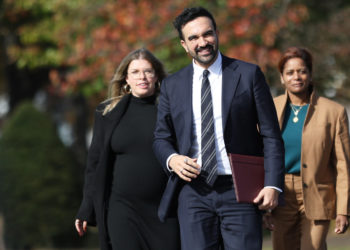Want to stay current with Arthur’s writing? Sign up to get an email every time a new column comes out.
One of the Beatles’ most beloved songs is “When I’m Sixty-Four,” the second track on Side 2 of their groundbreaking 1967 album, Sgt. Pepper’s Lonely Hearts Club Band. It features a 24-year-old Paul McCartney singing to his lover, asking whether she will still love him in the distant future, when he is a hopelessly ancient and decrepit 64-year-old.
When I get older, losing my hair
Many years from now,
Will you still be sending me a valentine,
Birthday greetings, bottle of wine?
This humorous, slightly schmaltzy ditty nonetheless poses a profound question for every long-term couple: Will you, in fact, find me attractive when we’re old? I had this very question in mind recently, as I contemplated the 34th anniversary of my own wedding. My wife wondered the same thing.
Neither of us is quite 64 yet (getting close), but I’m confident the answer for us both will turn out to be yes—though not for the things that attracted us to each other when we married, at 27. What keeps people in love is not what makes them fall in love in the first place. Understanding this might just keep your partnership intact until you are 64—and beyond.
The notion that romantic attraction is purely a function of social and cultural forces is a common assumption. These factors do matter, but evidence from psychology and biology suggests that our amorous impulses owe more to nature than to nurture. One expert on the matter is David M. Buss, an evolutionary psychologist at the University of Texas. In his influential 1994 book, The Evolution of Desire, based on his study of some 10,000 people from cultures all over the world, Buss reported that, initially at least, heterosexual males are most attracted to fertility cues in females (attractiveness, health, youth), whereas females are attracted to resource cues (status, ambition, wealth).
Buss does not assert that these are the only traits that matter to men and women. Both sexes want someone who is kind, honest, and respectful. In other ways, people’s preferences vary a lot. But the general pattern is clear, as most people have probably experienced and would confirm, and this finding has been replicated many times by other researchers. For example, as an international team of academic researchers reported in the journal Evolution and Human Behavior in 2018, when men and women were shown photos of the opposite sex alongside information about their earning status, “ratings of attractiveness were around 1000 times more sensitive to salary for females rating males, compared to males rating females.”
When my wife and I met, I had approximately zero dollars in my bank account and, working as a musician, was barely making rent. Presented with the evidence above, my wife concluded that she must be an evolutionary outlier. Not so, it turns out. Researchers in 2017 found that women also regard high creativity in men as attractive, perhaps because this acts as a cue for intelligence and, therefore, future resources. Apparently, playing the French horn well can stimulate a prospective mate’s limbic system to sense that someone might have a path to good repute and financial stability.
Once a couple is past the early stages of romance, however, attraction starts to change. For example, writing in the journal Personality and Individual Differences in 2008, five researchers found evidence that once men are “restricted”—that is, in a committed relationship—they show a significantly weaker preference for lower body-mass index and lower waist-to-hip ratios in women (which are both common fertility cues). Similarly, researchers writing in 2021 showed that, with the passage of time, the physical attractiveness of mates becomes less important to men. This study noted that what does become more important over time, for both sexes, are two personality traits: openness and mutual trust.
Many other studies show the same pattern. For example, Buss notes that long-standing couples place a growing value on loyalty and dependability. Personality matters, too: In 2020, researchers who followed 87 couples who’d been married for at least 15 years (many of them for much longer, in fact) found that the success of their partnership was largely thanks to developing a high degree of positive emotional behavior. Humor, enthusiasm, and validation—understanding and accepting each other’s feelings and perspectives—were especially important. Another experiment, which studied the marital success of child-rearing couples over the first six years of marriage, demonstrated that the couples happiest over time have a high level of fondness and admiration for each other.
I’d add one other factor, too: the spiritual dimension. As I have written previously, research has found that couples of faith are happier if they grow more religious over the years and practice together. What’s good for your soul is also good for your marriage, it turns out.
None of this is to say that by the time they’ve reached their mid-60s, spouses don’t care anymore about good looks or abundant resources. On the contrary, we all like an attractive spouse, as well as someone who can support the family. As Buss notes in his work, these are the qualities that people will flaunt at all ages if they find themselves unexpectedly single or are seeking to switch mates. But in general, if you’re hoping for a lifelong union, you’d be making a mistake trying to keep your mate by offering only what attracted them in the first place. In a long-term partnership with one person that sustains companionate love, you should shift your effort toward nurturing qualities in yourself that are less superficial than looks or money. Here are three evidence-based rules to keep in mind.
1. Slap on the cuffs.
When I married in Spain, where I was working in an orchestra, I remember the advice I received from one of my colleagues to think carefully before my wedding, because the Spanish word for “wives” is the same as that for “handcuffs” (esposas). That seemed like a pretty dumb joke to me at the time; Spanish humor can be a bit on the nose for my taste. But since then, I’ve thought about that double meaning with more fondness: Far from being shackled, you can cultivate dependability and complete loyalty. This fosters a happy feeling of being almost physically attached to each other, in a way that endures.
2. Stay positive.
A toxic habit that plagues many marriages is bringing all of one’s negative emotions home because that is where it feels safe to express them. The result is that partners impose a deep negative burden on the one relationship that should bring them the most joy. The research findings cited above clearly show that a strong long-term pair bond relies on abundant positive emotionality, whereas negativity weakens it. Being positive does not occur spontaneously: You must resolve to bring your happiness home, not just your unhappiness, and endeavor to share it.
3. Grow in spirit—together.
Many long-term couples with a spiritual or religious bent describe their partnership as something like an antenna that makes them more receptive to the supernatural, an effect that becomes more powerful over time. For example, aging Hindu couples sometimes practice vanaprastha, the third of life’s four stages according to Hinduism, in which one focuses less on worldly things and more on theology by sharing in charitable activities, spiritual study, and pilgrimages. I obviously can’t verify by scientific means whether this connection to the divine is real, but a lot of research suggests that prayer and worship with another person can increase the emotional resonance of the practice and deepen the trust that a couple has in each other. For nonreligious couples, some research has also shown an increase in closeness when practicing certain kinds of meditation together.
Life provides no guarantees, including guarantees about love. People may change and plenty of disappointments can occur, including in relationships. But you and your beloved can do a great deal to tilt the odds in your favor that when you each turn 64, you’re still together and in love.
This starts by understanding that neither your physical beauty nor your worldly ambition are most important over the long haul. What truly matters is your virtue, your heart, your character, and your soul—all dedicated to your true love and expressed in both the big and the little things of life. McCartney seemed to sense this truth even as a young man. As he imagined a happy old age lived together, he wrote:
I could be handy, mending a fuse,
When your lights have gone.
You can knit a sweater by the fireside,
Sunday mornings, go for a ride.
Maybe that sort of companionship sounds tame and dull when you’re a hot, hard-charging 24-year-old. But trust me and Mrs. Brooks, as we mark our 34th wedding anniversary: It’s great.
The post What a Young Paul McCartney Knew About Growing Old appeared first on The Atlantic.




